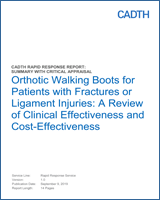Outcomes in pediatric patients (9 months to 4 years) with ankle fractures (Note: Initial immobilization was with long leg cast in 53 patients, short leg cast in 83 patients, and boot in 46 patients. Twenty-three patients with the long leg cast and 28 patients with the short leg cast changed to boot after a mean duration of 10.9 days and 13.5 days respectively. Also, 19 patients with the long leg cast and 2 patients with the boot changed to the short leg cast after a mean duration of 8.7 days and 10.5 days respectively. Reasons for change were not presented. This resulted in final immobilization with the long cast, short leg cast, and boot in 11, 77, and 97 patients respectively) Return to weight bearing (weeks): 2.5 for the group with initial immobilization with boot and 2.8 for the group with initial immobilization with short leg cast, P = 0.04. Note that results for the comparison of boots versus long casts were only presented graphically (i.e., not described in the text, so there are no results to report here). There was no statistically significant difference in time to weight-bear based on final type of immobilization (P = 0.20). Adverse effects: There were 3 superficial skin ulcer complications in the group with initial immobilization using cast. No other complications were reported. | “This study, to our knowledge, represents the largest cohort of toddler’s fractures in the literature. The findings demonstrate the inherent stability of the fracture and therefore successful treatment no matter the immobilization type used, without aid by follow-up radiographs. We recommend immobilization based on family and physician agreement, although the use of a boot may speed weightbearing and avoid cast sores.” (p. 316–317) |
Outcomes in adult patients with ankle fracture who underwent surgery, and then were prescribed either a walking boot (WB) or plaster cast (PC). Time duration after which the patients were allowed to put full weight on affected side (mean ± SD) (weeks): 5.5 ± 0.9 with WB, 5.8 ± 1.5 with PC; P = 0.732. Time duration for the patient to stand unipedal on the affected side after allowing full weight bearing (mean ± SD) (weeks): 1.4 ± 1.7 with WB, 3.1 ± 2.2 with PC; P = 0.003 Time duration for the patient to walk without crutches (mean ± SD) (weeks): 2.6 ± 1.8 with WB, 4.5 ± 2.3 with PC; P = 0.001 ROM of ankle (within-patient differences between the affected and unaffected sides), (mean ± SD) (weeks): 5 ± 3.8 with WB, 5.2 ± 2.8 with PC; P = 0.842 Loss of reduction: none in both groups Nonunion: none in both groups | “The WB treatment results in faster functional recovery, allowing the patients to return to normal activities at a faster rate.” (p.13) |
Outcomes in pediatric patients (9 months to 3 years) with toddler’s fracture Duration of immobilization (mean [95% CI]) (days): 27.0 (23.5 to 30.9) for WB group, 27.5 (26.0 to 29.1) for CS group, and 4.1 (2.8 to 5.9) NM group; P < 0.001 (based on available data i.e., data from 8, 43, and 7 patients in WB, CS, and NM groups respectively). Some patients in the NM group who were followed up at an orthopedic clinic were subsequently immobilized. Number of orthopedic follow-up visits (mean [95% CI]): 1.2 (0.8 to 1.9) for WB group, 1.3 (1.0 to 1.6) for CS group, and 0.9 (0.3 to 1.9) for NM group; P < 0.001. Change (%) in therapy at follow-up (mean [95% CI]): 27.3 (6.0 to 61.0) for WB group, 10.4 (3.5 to 22.7) for CS group, and 50.0 (6.8 to 93.2) for NM group; P = 0.04 (based on available data i.e., data from 8, 43, and 7 patients in WB, CS, and NM groups respectively). Number of repeat radiographs (mean [95% CI]): 0.5 (0.2 to 0.9) for WB group, 2.1 (1.7 to 2.5) for CS group, and 0.4 (0.1 to 1.3) for NM group; P < 0.001. Return to emergency department after initial treatment (%) (mean [95% CI]): 0 (0 to 18.5) for WB group, 8.0 (2.2 to 19.2) for CS group, and 14.3 (0.4 to 57.9) for NM group; P = 0.3. Skin breakdown (%) (mean [95% CI]): 0 (0 to 28.5) for WB group, 26.5 (15.0 to 41.1) for CS group, and 0 (0 to 60.2) for NM group; P = 0.1 (based on available data i.e., data from 11, 49, and 4 patients in WB, CS, and NM groups respectively). None of the patients who were not immobilized, and 9.6% of the patients who were immobilized at their initial visit, returned for concerns with pain. Note: Results pertain to the “initial treatment” group (initially there were 18, 50, and 7 patients in WB, CS, and NM groups respectively) Also, data for all outcomes were not recorded for all patients and analyses were based on available data. | “This study demonstrates the wide variation in management of toddler’s fractures while highlighting the potential harm done by unnecessary splinting and casting. The incidence of skin breakdown related to splinting and casting was a concerning finding.” (p.4 of 6) |
